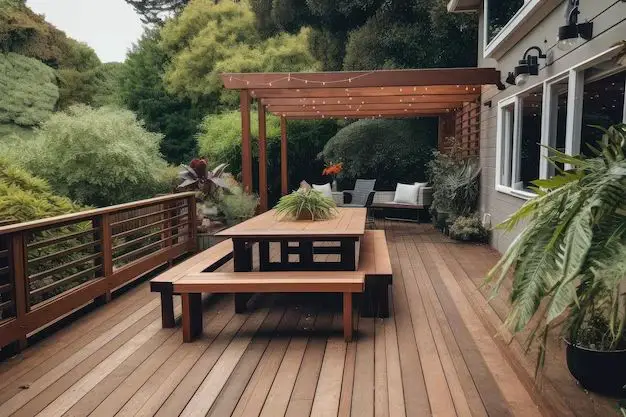When it comes to choosing the best shade for your deck, there are a few key factors to consider. The main goal is typically to block out excessive sunlight and heat during the warmer months so you can better enjoy your outdoor living space. The ideal deck shade solution will provide cooling shade while allowing enough light through to prevent a dark, dreary feel. It should also complement your home’s aesthetic and withstand the elements.
Page Contents
Location and Sun Exposure
The first consideration is the location and sun exposure of your deck. Determine what direction it faces and how many hours per day it receives direct sunlight. South-facing decks typically get the most sun, while north-facing decks get the least. East and west-facing decks get morning and evening sun respectively. If your deck is exposed to sunlight most of the day, you’ll likely want shades that block a significant amount of light and heat. With less sun exposure, you may opt for shades that let more light filter through.
Also note obstacles like trees and buildings that may already provide some shade and cooler spots at certain times of day. Pay attention to the angle of the sun at different times and how shadows move across the deck. This will help you choose the best shade locations to maximize coverage during the hottest part of the day.
Types of Deck Shades
There are several options when it comes to deck shade structures:
- Umbrellas – These portable shades can be easily moved around the deck to provide shade wherever and whenever needed. They come in a variety of styles, sizes, and colors to match any deck’s look.
- Sails – Triangle or square fabric sails mount to posts at corners and edges to create graceful, billowy overhead coverage.
- Pergolas – Permanent wooden lattice structures provide an open, breezy cover that still allows filtered sunlight.
- Pavilions – Roofed structures made of wood or metal that offer solid, waterproof shade from direct sunlight.
- Awnings – Retractable fabric covers that extend from the house over the deck area when needed.
- Trees – Strategically planted trees or shrubs can provide natural shade coverage.
Consider the pros and cons of each when choosing the right option for your needs and preferences:
| Type | Pros | Cons |
|---|---|---|
| Umbrellas |
|
|
| Sails |
|
|
| Pergolas |
|
|
| Pavilions |
|
|
| Awnings |
|
|
| Trees |
|
|
Size and Placement
Also consider the size and placement of your deck shades. The shades need to adequately cover the main seating/relaxation areas while not feeling overly restrictive. Umbrellas, sails, and pergolas work well centered over a table and chairs. Pavilions and awnings can cover the entire deck footprint. For larger spaces, incorporate a combination of elements like umbrellas and pergola sections to customize coverage across different zones.
Make sure to leave some area uncovered for pets or kids to play, and for grill smoke ventilation. Leave enough headroom so the shades don’t feel too low and enclosed. Most experts recommend at least 6 feet 8 inches of clearance. Finally, check that your shades don’t obstruct important views from your deck.
Material and Design Choices
The material and design details of your deck shades also impact functionality and appearance:
- Fabrics – For sails, umbrellas, and awnings, look for lightweight, breathable, water-resistant fabrics like polyester, acrylic, or olefin in neutral or colorful shades that complement your home. Darker colors absorb more heat.
- Wood – Cedar, redwood, or pressure-treated pine are good woods for pergola frames, resisting moisture, pests, and mold. Look for durable, responsibly sourced woods.
- Metals – Powder coated aluminum allows pavilions and pergolas to withstand sun, rain, and salt without rusting.
- Openness vs. Solidity – More open frames like pergolas allow breezes and light through while still providing a sense of shade. Retractable awnings and pavilions offer more complete sun and rain coverage.
- Neutral vs. Bold Colors – For long-lasting appeal, stick with versatile, neutral shade colors like beige, brown, tan, or off-white. For a pop of personality, choose vibrant umbrella colors or patterned sail fabrics.
IPEMA-Certified Umbrellas
For umbrellas, look for models certified by the International Patio Umbrella Manufacturers Association (IPEMA). These umbrellas undergo testing for:
- Wind resistance – rated to withstand gusts of at least 35 mph.
- Exposure durability – rated for 3,000 hours of UV light exposure.
- Corrosion resistance – metals won’t corrode due to rain, moisture or salt.
- Fabric strength – rated for several hundred hours of wear before fading.
IPEMA umbrellas provide reliable safety and longevity. Center pole umbrellas tend to be sturdier than offset umbrellas.
Automated or Retractable Shades
For convenience, you can find shades with handy automated features:
- Motorized awnings you can extend/retract at the touch of a remote or app.
- Umbrellas with crank lifts make opening and angling effortless.
- Light sensor umbrellas automatically open when the sun comes out and close again in cloudy conditions.
These systems take the hassle out of handling deck shades and make it easy to control sun exposure. However, they add to the complexity and cost of the shades.
Conclusion
The ideal deck shade for you depends on your specific deck location, sun exposure, size, and aesthetic preferences. Seek a balance of enough coverage to actually block heat and light, without feeling too enclosed and dark. Prioritize shade over seating/dining spaces. Choose sturdy, durable materials that can withstand sun, wind, and rain in your climate. And consider convenient features like automated operation or easy lift mechanisms. With the right deck shade, you’ll be able to enjoy your outdoor living space even more during the warmest months.
